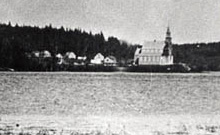 Holy
Trinity Church seen from the site of the present-day community. This
picture was taken in 1907 by A.F.McKay who was a law student from St.
John's College in Winnipeg. He was working at a summer job on the Federal
Survey Commission that surveyed Indian reserves in northern Saskatchewan.
Holy
Trinity Church seen from the site of the present-day community. This
picture was taken in 1907 by A.F.McKay who was a law student from St.
John's College in Winnipeg. He was working at a summer job on the Federal
Survey Commission that surveyed Indian reserves in northern Saskatchewan.
Note: The church is unpainted and is not yet covered with sawmilled lumber. It appears that perhaps this process has begun on the lower front part of the building. Also, the steeple is the original high steeple.
A large part of the community was located around the church at this time.
 A
whip or pit saw believed to be one of the original saws used to saw
the lumber for Stanley Mission Church. At one time there were two saws
from the building of the church that were in the community.
A
whip or pit saw believed to be one of the original saws used to saw
the lumber for Stanley Mission Church. At one time there were two saws
from the building of the church that were in the community.
The saws were circulated for many years throughout the community as people needed to make lumber for roofs, floors, etc. This saw was used to saw planks for tent floors by the McKenzie family at their trapline at the north end of Lac LaRonge, near Rapid River, in the summer of 1959 or 1960.

Holy Trinity Church in the 1920's, from the back.
Note the unpainted original handsawn lumber siding and the original high steeple. Also note the absence of buildings on the far shore where the present community is now located.
 Interior
views of Holy Trinity Church in 1957-1960, taken on three different
occasions.
Interior
views of Holy Trinity Church in 1957-1960, taken on three different
occasions. 

Note what must have been one of he longest stovepipes in the world which used to be attached to two iron heaters for winter.
Only those who have had the frustrating experience of assembling stovepipes can appreciate the heroic effort here and properly understand why the pipes were carefully propped for the next season.
In the picture on the extreme right, the additional flags are likely up for a visit from the Bishop.